Lord Hanuman was born in the house of Anjana, the wife of Kapiraj Kesari. Hanuman is said to be an incarnation of Lord Shiva. As Lord Shiva could not serve Lord Ram in his own form, he incarnated as the eleventh form of Rudra, Hanuman. The devotion of Hanuman towards Shri Ram is truly epic.
Childhood Bravery of Hanuman
Shortly after birth, Hanuman considered the rising Sun to be a red fruit and ran towards it to swallow it. That day was the time of the solar eclipse. Rahu saw that someone else was coming to catch the Sun.
Rahu rushed to confront him, but when Vayuputra Hanuman charged towards him, he got scared and ran away. Rahu called out to Indra. Seeing Indra coming on Airavat, the elephant, Hanuman mistook Airavat for a big white fruit and rushed to catch it.
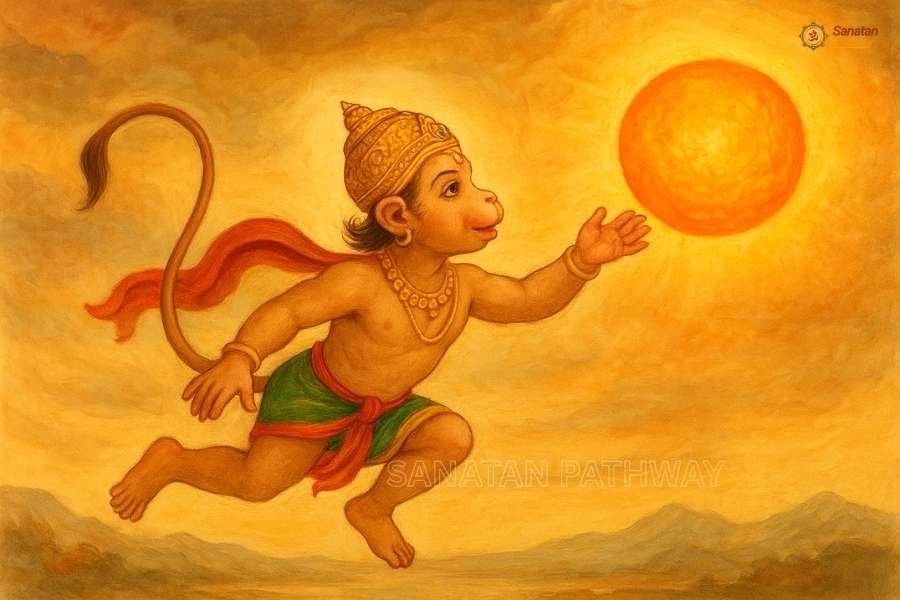
The Boon of Being Immortal
Frightened, Devraj Indra struck with the thunderbolt. Due to the thunderbolt hitting his chin (Hanu), it became somewhat crooked. As a result, he came to be known as Hanuman. When the thunderbolt struck, he fell unconscious to the ground. Seeing his son unconscious, Vayudev became very angry. He stopped his pace (air flow).
Even the Gods became distressed due to the stoppage of breathing. At last, all the Gods satisfied Vayudev by giving Hanuman the boon of being immortal and fearless of fire, water, air, etc. But despite such divine blessings, Hanuman’s mischievous and playful nature soon created troubles for the sages, leading to an unexpected curse.
Why Hanuman Was Cursed
Hanuman, being playful by nature, would often break trees in the sages’ ashrams with ease and destroy the items within. Therefore, the sages cursed him: “You will forget your strength. Only when someone reminds you of your strength will you become aware of yourself.”
You will only remember your strength when reminded by others.
Since then, he started living like a normal monkey. At his mother’s command, Hanuman approached Suryanarayan and studied all the scriptures. He also acquired the Vedas, Vedangas, and Ashta Siddhis.
After that, he came to Kishkindha and began living with Sugriva. Sugriva made him his personal secretary. Even when Bali defeated Sugriva and expelled him, Hanuman remained with Sugriva on Rishyamukha Hill.
Hanuman’s Devotion Since Childhood
As a child, Hanuman often listened to divine stories of Lord Vishnu from his mother, Anjana. During his studies, he learned from the Puranas about the coming incarnation of Shri Ram. From that moment, Hanuman began waiting with great eagerness to see his master.
It is said in Srimad Bhagwat:
“One who, while eagerly waiting for God’s grace, happily accepts both happiness and sorrow received from his destiny, keeps saluting God with his heart, speech, and body, thinks of God with his heart, sings praises of God’s name and qualities with his speech, and worships Him with his body, such a devotee attains salvation.”
Lord Hanuman was completely free from the bondages of Maya since birth. He always remained absorbed in thoughts of his master, Shri Ram.
Hanuman Meets Shri Ram
In time, Shri Ram, along with Lakshman, reached Rishyamukh in search of Sita after she had been kidnapped by Ravana. Sugriva suspected that his brother Bali might have sent these princes to kill him. Therefore, he sent Hanuman to learn about them. When Hanuman approached Shri Ram and Lakshman and received their introduction, he immediately fell at their feet in deep devotion.
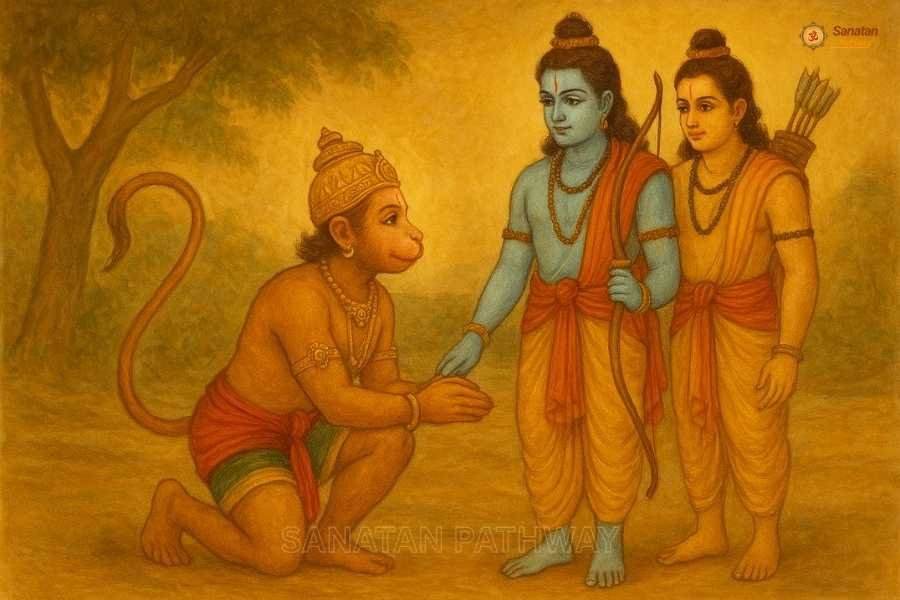
When Hanuman Got His Strength Back
Shri Ram picked Hanuman up and held him close to his heart. Since then, Hanuman remained near Shri Ram. By Hanuman’s request, Shri Ram made a friendship with Sugriva, killed Bali, and gave him the kingdom of Kishkindha.
1. Reminder of Duty
When Sugriva became lost in worldly pleasures, it was Hanuman who reminded him of the duty to seek Sita. It was also Hanuman who gathered the monkey army. Soon, Shri Ram entrusted him with the mission to go to Lanka in search of Sita, giving him his ring as a sign.
2. Jambavanta’s Reminder
When the question of crossing a hundred yojanas of the sea came, Jambavanta reminded Hanuman of his forgotten strength. He said, “Your incarnation has been to accomplish the work of Shri Ram.” Then Lord Hanuman, realizing his power, prepared himself to leap across the ocean.
3. Crossing the Ocean
It is said that Hanuman Ji went with such speed for Shri Ram’s work that only his outline was visible, and he could not be clearly seen. On his way, he satisfied the serpent Surasa, whom the Gods sent to test his strength and intelligence. Hanuman killed the demon Simhika, who was hiding in the sea, and finally reached Lanka.
Hanuman’s Journey to Lanka
Hanuman entered Lanka at night, assuming a small form, and struck down the gatekeeper Lankini with a single punch. After receiving guidance from Vibhishana, he visited Mata Sita in Ashoka Vatika and showed her the ring given by Shri Ram. He assured her of rescue and, in his might, went on to destroy the Ashoka Vatika.
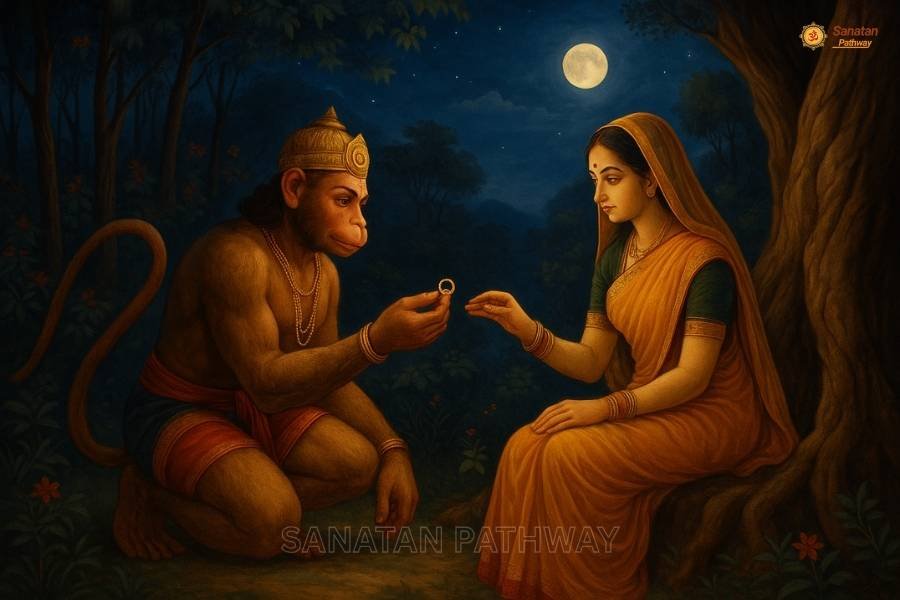
He killed many demons, including Akshaya Kumar, Ravana’s brave son. Later, Meghnad bound Hanuman with the Brahmastra and took him to the royal assembly.
There, Hanuman fearlessly advised Ravana to abandon his pride and surrender to Shri Ram. Enraged, Ravana ordered Hanuman’s tail to be set on fire. But with that very fire, Hanuman leapt across Lanka, burning down its golden palaces and terrifying its demons.
He then returned to Shri Ram with Chudamani as a token from Mata Sita. On receiving this news, Shri Ram prepared for battle. A bridge (Ram Setu) was constructed across the sea, and the great war with Ravana began.
How Hanuman Saved Lakshman’s Life
During this fierce battle, Lakshman became unconscious, struck down by the weapon of Meghnad. Seeing this, Shri Ram’s heart trembled with grief. To save Lakshman’s life, Hanuman flew to the Himalayas, killed the heretic Kalanemi on the way, and carried the Dronachal mountain with the life-giving Sanjeevani herb. When the herb touched Lakshman, he regained consciousness.
It is also said that Hanuman once brought the Govardhan mountain to Vrindavan. Later, when the illusory Ahiravana stole Rama and Lakshmana from the battlefield, Hanuman went to the underworld, killed Ahiravana, and rescued the brothers.
With Lakshman revived and Rama safe, the battle raged on. Hanuman’s courage and strength inspired the monkey army, while the demons trembled at his mighty roars. Finally, Ravana and his forces were destroyed, and victory was achieved.
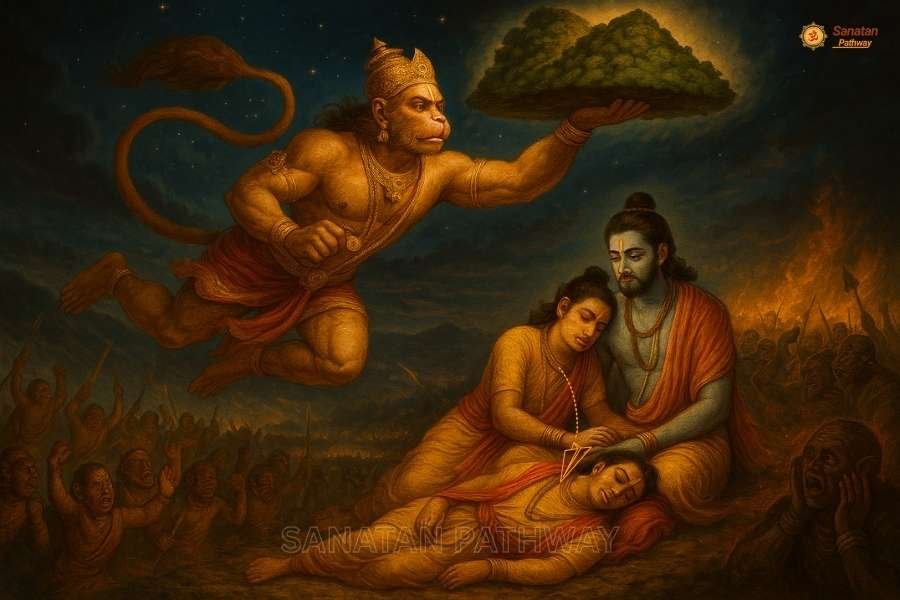
Other Qualities of Hanuman
He is the embodiment of learning, intelligence, knowledge, and bravery, but despite all this, his pride never touched him. Hanuman is a lifelong faithful celibate. He is a renowned scholar of grammar, a scholar of the Vedas, a master of knowledge, and a profound thinker.
Apart from his knowledge and strength, Lord Hanuman was also a highly skilled musician and singer. This divine talent once shone in a great conference of Gods, where Lord Shiva and Devarshi Narada were singing. Other Gods, sages, and even demons were also giving raga.
Meanwhile, Hanuman began singing a beautiful song in a sweet voice, and their faces turned pale with awe. They all stopped their own singing and became completely fascinated, listening silently. At that moment, only Hanuman’s divine voice filled the air.
Free from Pride and Lover of Ramkatha
As long as the divine story of Shri Ram remains on earth, Hanuman himself asked the Lord for the boon of staying here. During the Ashwamedh Yagya of Shri Ram, when many great battles took place to protect the sacrificial horse, Hanuman’s bravery was victorious everywhere.
1. Hanuman in the Mahabharata
In the Mahabharata, too, Hanuman revealed his presence. He used to sit on the flag of Arjun’s chariot, and with him present, no one could push Arjun’s chariot backward. He also protected Arjuna on many occasions.
2. Hanuman’s Humility in Literature
Once, he even saved Bhima, Arjun, and Garud from pride. It is said that Hanuman had written a Ramcharita-kavya on the rocks of his Vajranakhse mountain. But when Valmiki felt sad that if this poetry became popular in the world, then my original poetry would not be respected. To satisfy the sage, Hanuman threw those stones into the sea. A true devotee has no desire for fame, respect, or glory. He only sings the holy praises of his Lord in the world.
3. Hanuman’s Love for Ramkatha
Hanuman is a great lover of listening to Shri Ram’s katha and Ram’s name kirtan. Wherever a kirtan in the name of Ram is held, he reaches there secretly at the very beginning. He stands there humbly, with folded hands placed on his head until the end. Out of pure love, tears continuously stream down his face.
4. The Divine Garland of Gems
All the divine gems that emerged during Samudra Manthan were stored in Ravana’s treasure. When Vibhishana was crowned after Ravana, he made a garland from those gems and offered it with great devotion at the feet of Shri Ram in gratitude. The hearts of all the monkeys and bears yearned for that divine necklace.
When Hanuman Tore Open His Heart
Hanuman was also present in the assembly, yet his mind was completely absorbed in drinking the nectar of devotion from the radiant beauty of his beloved Shri Ram. Seeing this, the Lord placed the divine garland around the neck of Hanuman.
Hanuman looked at the necklace, then took out each gem and started breaking it with his thunderbolt-like teeth. Seeing him doing this, Vibhishan asked:
“Hanuman! Why are you destroying these priceless gems?”
Hanuman replied humbly:
“If the sacred name of Shri Ram is not inscribed within these gems, then to me, they hold no value.”
Vibhishan then said:
“But Hanuman, the name of Ram is not written anywhere on your body. Then why do you value it so dearly?”
Hearing this, Hanuman, with divine fervor, tore open his own heart. To everyone’s astonishment, within his chest shone the resplendent forms of Shri Ram and Mata Sita, seated in eternal glory.
This story symbolizes Hanuman’s unmatched devotion. His life teaches us strength, humility, and complete surrender to God. That is why Hanuman remains eternal, inspiring millions of devotees across generations.

I’m Manohar Prajapat, founder of Sanatan Pathway.I write about Sanatan Dharma, Bhakti Leela, Hindu festivals, and the timeless wisdom of the Vedas — to help people live a more peaceful, dharmic life rooted in Indian spirituality.🕉 Read more at sanatanpathway.com
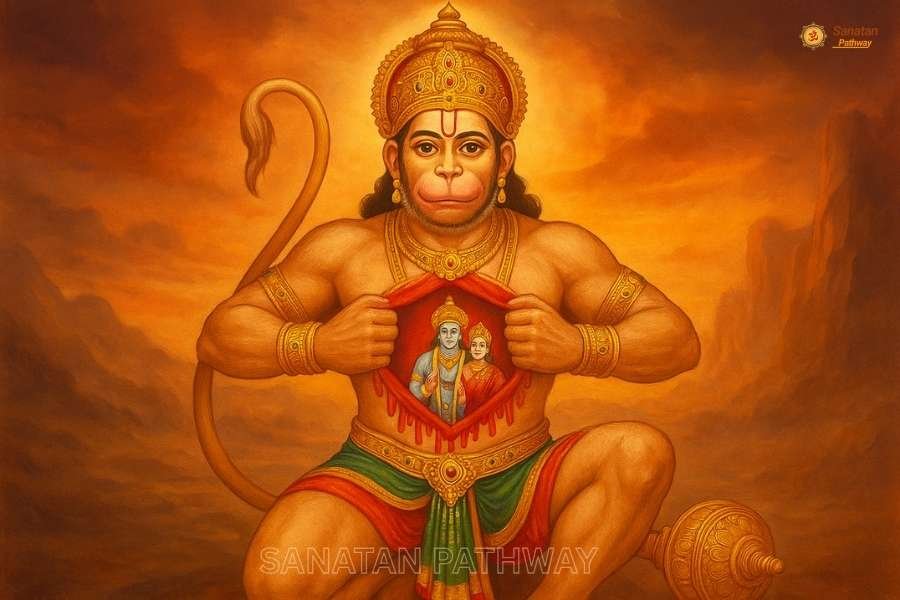
1 thought on “Devotion of Hanuman: The Story of Shri Rama’s Eternal Devotee”